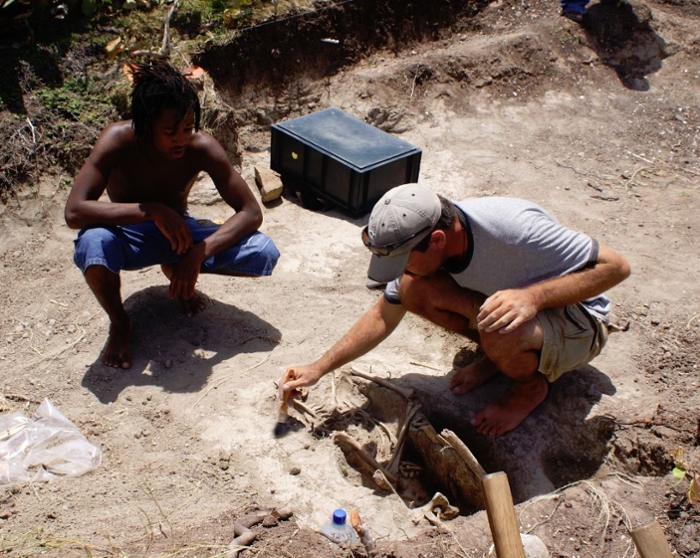
Jason Laffoon’s Leiden Experience: ‘I am expanding my horizons chronologically and regionally’
Back in 2008, Jason Laffoon moved from Chicago to Leiden. He came to join the Faculty of Archaeology’s Caribbean research group as a PhD candidate. Now he is an assistant professor, bridging departments through his innovative research methods. ‘I focus both on the archaeology of the Americas, as well as on methods in Archaeological Science, like isotope studies.’
Volunteering
Jason finished his BA and MA in Anthropology and Archaeology at the University of Illinois, Chicago. Looking for fieldwork opportunities, his supervisor recommended him to volunteer for a Dutch team of archaeologists, led by Prof. Corinne Hofman and Dr. Menno Hoogland. ‘I thought it was a great idea, so I met up with them at a conference and introduced myself.’ He was more than welcome to join. ‘So for several summers in a row, I joined their fieldwork projects. It was very enjoyable.’

Communicating Communities
When Jason had graduated, he started looking for a PhD position in the US. However, his Leiden connections had another suggestion. ‘I was pointed to a PhD vacancy in Leiden, coming forth from a very large NWO-Vici research grant to the project Communicating Communities. I applied for the position, and I got it! So I moved to Leiden in 2008.’
Settling in Leiden was relatively easy for Jason. ‘In hindsight, I didn’t know much about Holland. I often tell my Dutch friends that it probably was less of a cultural transition here than it would have been if I had moved to a place like Nebraska or Alabama.’
Luck, hard work, and determination
Three years into his PhD, he was invited to write sections in two large grant applications under the direction of Professor Corinne Hofman. ‘As a non-European, I needed to meet my PhD deadline so I didn’t really have the time. Still, it was worth a shot, so I wrote exactly what I would want to do.’ As the applications were pending, he graduated and stayed at the Faculty as a lecturer, filling in for Dr. Andrea Waters as she was on research sabbatical. Then the news came: both the ERC as well as the NWO grants were awarded. ‘I was really lucky with the timing. And, aside from luck, a lot of hard work and determination was involved.’

The hard science stuff
As a result of being part of two large research projects, Jason did two postdocs at the same time. ‘One of them was in the NWO-funded Island Networks, focused on the Lesser Antillean islands, with the same research topics I had been working on for years, like migration, diet, and life experiences.’ For the second one, the ERC-funded NEXUS1492, Jason was stationed at the Vrije Universiteit Amsterdam. ‘There I worked under the supervision of Professor Gareth Davies at the Laboratory of Geology and Geochemistry. That’s really the hard science stuff, like isotope analysis.’ In the meantime, he was promoted to Assistant Professor.
A final synthesis
Now, NEXUS1492 is in the process of being wrapped up. ‘The main thing we are working on now is the final synthesis of the project. This will be in the form of an edited book, in which the Principal Investigators will be the main editors.’ The senior researchers are taking the lead to writing the chapters, which will all be collaborations and crossing disciplines. ‘There are 60 researchers involved, from several different institutions. It’s a big project.’ The book will probably be published in spring 2020.
Bridging two departments
The last couple of years Jason got much more involved in education. His current position is forming a bridge between two departments. ‘I am teaching in two different departments, in World Archaeology as well as Archaeological Science. That’s basically the plan for the coming years, teaching at BA and MA level and supervision of more PhD students.’
And, of course, research goes on as well. ‘I am fortunate that I developed a very large network of collaborators. My research has expanded out of America. Currently I am active in projects on Iron Age southern Italy; 17th century survivors of the shipwreck of the Batavia off the coast of Australia; 18th century enslaved Africans; and 19th century orphans from Amsterdam. I am expanding my horizons chronologically and regionally.’

Immigrant
Even more exciting is Jason’s application for an ERC Starting Grant. He has been invited to Brussels in June for an interview. ‘The research proposal is called IMMIGRANT. We made a lot of progress archaeologically identifying who has been migrating, but we do not know what happens to people after they migrate.’ The proposal is all about intensively examining human remains. ‘Stress, famine, age of death, these are all factors we want to investigate. We can zoom in on individuals and see what happened to them in their lifetimes.’ We will keep our fingers crossed.
Pass on the trowel
In this series we ask a staff member to pick a colleague of whom they would like to know more. Jason Laffoon passed on the proverbial trowel to Rachel Schats. She will be interviewed for the newsletter of August 2019.
